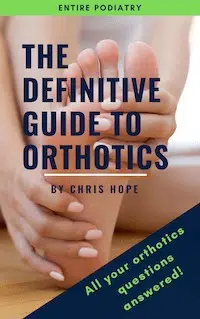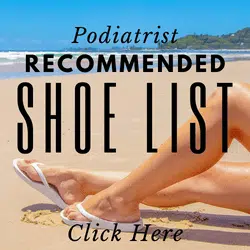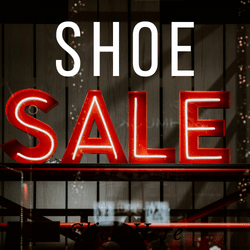Finding the right shoe that works well with your orthotics is just as important as the orthotic itself. It is the combination of the correct orthotic and correct shoe that will properly improve your foot function and reduce your pain.
It is now much easier to find suitable shoes that accept orthotics. You no longer need to sacrifice style to find shoes for custom orthotics. There is now a wide range of fashionable shoes for orthotics. Our podiatrists understand that in order for the orthotics to be beneficial, you have to actually want to wear them! And this means that you will need to like the shoes that they fit into.
The market is growing for ladies shoes that are suitable for orthotics. And there are now more men’s shoes with removable insoles for orthotics. View our orthotic-friendly shoes.
Our podiatrists can recommend and provide you with an information pamphlet detailing many different brands of shoes with removable insoles for orthotics and will teach you how to know if the shoes are made for orthotics. We can assist with finding the best shoes for running, golf, netball, winter sports such as skating and skiing, football – AFL, rugby, soccer, cycling, dance shoes and more.
Orthotics and dress shoes
How do I know if my dress shoes will fit orthotics?
Typically, shoes that are made for orthotics will have an innersole that can be removed from the shoe without damaging the shoe. The innersole is then removed and the orthotic is worn in the shoe instead. Having a removable innersole will free up more space inside the shoe for the orthotic. However having a removable innersole is not a requirement; at Entire Podiatry we have designed many orthotics to fit into just about any dress shoe. We work with a range of different state-of-the-art materials which are thinner but just as long-lasting and supportive as traditional orthotic materials and fit into a wider range of shoes. These orthotics are narrower than a standard orthotic, have a low heel cup height and a very thin cover so that they leave room for your toes.
We are often asked ‘What are the best shoes for orthotics inserts?’ or ‘What are the best shoes for orthotics in Australia?’ This is difficult because it will depend upon your particular need and the type of dress shoe you would like to wear. This will dictate what type of orthotic we can design. For example if you have pain in the ball of the foot, from wearing high heels, then the orthotic should be designed to transfer the weight from the ball of the foot and the heel and distribute onto the arch. For women a good orthotic can make high heels, flats, wedges, boots and even sandals more comfortable. For men we can make orthotics for boat shoes, loafers, dress shoes and sandals.
If you have had orthotics made at Entire Podiatry then we should already have your scans on file. A lot of patients have orthotics for sports shoes and another for dress shoes or sandals. If you want an additional pair it is important to know what type of shoes you want to wear, so we would suggest making an appointment to see a podiatrist. There are many choices when it comes to prescribing orthotics so we need to discuss your shoe requirements and lifestyle so that we can make the best orthotic possible.
Sometimes we have patients ask us ‘can I have an orthotic made for backless dress shoes?’ It is very difficult for an orthotic to stay in place in this type of shoe and in these circumstances we have had succeeded by using stick-on arch pads or domes. By using these stick-on pads we can redistribute weight across the whole length of the foot and can even reduce leg and back pain. If you suffer with heel pain, bunions, pain in the big toe joint and ball of foot pain, when wearing backless shoes make an appointment at Entire Podiatry today (appointment link).
If you have a particularly wide or difficult to fit foot, or if your requirements mean that your orthotic device is quite thick then extra depth shoes for orthotics may be required. At Entire Podiatry we can recommend and sell a range of shoes “Dr Comfort” which sell a range of double depth shoes for orthotics to ensure your feet fit comfortably.
Orthotics for sandals
What about summer shoes for orthotics? Are there sandals suitable for orthotics?
Yes! There are a number of footwear brands which have carefully designed sandals that can be worn with orthotics.
Typically orthotics do not fit well into regular sandals, you will need to look out for sandals with removable innersoles for orthotics.
Your podiatrist can discuss with you the important features to look for in an orthotic-friendly sandal to ensure the correct fit. We can recommend a number of brands of both men and women’s sandals suitable for orthotics. We have had fantastic results for many patients by designing the perfect orthotic for sandals.
If you have a sandal with a moulded footbed already, such as the Birkenstock, but still require additional support then we have the option of sticking pads and domes to reduce pain and improve alignment.
Best kids shoes for orthotics
School shoes are an important purchase for children. While school shoes don’t need to be expensive to fit orthotics, they do need to fit well and offer adequate support. You also want them to be durable enough to last until your child grows out of them.
Ideally, a school shoe that will work well with an orthotic is one that has a firm heel counter. The heel counter is the part of the shoe that wraps around the back of the heel, if this material is nice and firm it will hold the orthotic in place and support your child’s foot well.
A good shoe should have the right degree of flex and bend. When testing for this, bend the shoe. A good shoe should bend across the ball of the foot, where you would imagine the ball of the big toe to sit. If the shoe bends right in the middle then the shoe will likely be too soft and flexible and may not support your child’s feet as well as they should.
School shoes with a removable innersole typically work well with an orthotic. Depending on the shape and width of child’s foot, a more comfortable fit may be achieved when wearing both the orthotic and the regular innersole or the orthotic alone. If your child has a very wide foot and the shoe is too tight when worn with the orthotic inside then they may need extra wide toddler shoes for orthotics to give them a little bit more space inside the shoe.
Read more about choosing the best school shoes for children.
What are the best running shoes for custom orthotics
There is no single best running shoe for orthotics that will work for everyone.
Good running shoes for orthotics will depend on your foot type, your orthotic and the type of activity you are planning to do. Finding the right type of shoe to wear with your orthotics will be important for comfort, performance and reducing the chance of injury.
Find the best running shoe for your foot type
Your orthotic will be designed based on your specific foot-type and your ’biomechanics’. Put simply, if your running gait assessment reveals that you over-pronate i.e. collapse in at the foot, arch and ankle, then your orthotics will likely be designed to address this and to correct this over-pronation to transfer the forces away from the inside of the foot and leg.
Alternatively, if your running gait assessment reveals that you under-pronate or you have poor shock absorption, your orthotics will likely be a cushioned device to improve shock absorption and to transfer the forces away from the outside and the front of your leg.
It is important then that your chosen shoes work well and compliment the goal of your orthotics. A common mistake is for someone who over-pronates or has ‘flat feet’ and has a pair of orthotics to address this and to then purchase what the shoe store tells them is the ‘best running shoes for flat feet and orthotics’.But in fact they are now being ‘over-corrected’ meaning that the combination of the orthotic and these very supportive shoes and now pushing them too far to the outside of the foot. This can create a new array of problems.
This is why we always recommend an assessment by a podiatrist to ensure that your orthotics and shoes are giving you the correct degree of support.
How to find a running shoe to fit your orthotic
It’s not hard these days to find running shoes that fit orthotics. Most good quality sports shoes will be able to accommodate orthotics. The orthotic can change the feel and fit of she shoe. Occasionally, but certainly not always, people like to go up a half or full size when the orthotics are worn in the sports shoes. This is why we recommend that when you buy your shoes you take your orthotics with you to the store so you can try them on together.
Consider the type of activity
Each activity has different requirements and specifications and the shoe will be designed differently to meet that requirement. For example, the best cross training shoe for orthotics will be a shoe that is able to tolerate lots of change in direction, especially side-to-side movement with a flexible sole. Typically a cross training shoe will have a lower drop, e.g. will be a flatter shoe which increases the stability and risk of ankle sprains during jumping activities.
The best running shoe for orthotics will typically be one with more cushioning than a cross trainer and may have a slightly higher heel drop. This helps with forward motion and increases shock absorption to reduce the chance of these types of injuries.
The best trail running shoes for orthotics will be a shoe with good external grip to navigate uneven or slippery terrain. The sole may be slightly thicker to protect the feet from sharp objects and the shoe may extend slightly higher around the ankle to increase the ankle stability.
Here are some of the many common injuries we see associated with running at Entire Podiatry :
- Shin Splints
- Plantar fasciitis
- Achilles tendonitis
- Sesamoiditis
- Posterior tibialis tendonitis
- Subungual hematoma
- Peroneal tendonitis
- Metatarsal stress fracture
- Patellofemoral pain syndrome
Recently there has been evidence published which highlights the value of orthotics for runners in terms of preventing injuries, reducing pain symptoms, and improving recovery.
There have been many studies which show orthotics can reduce running related injuries and here is some information on what they have found.
A study by Hirschmüller and colleagues in 2009 studied the effect of foot orthotics on running injuries. This randomised controlled study found a statistically significant reduction in pain from lower extremity overuse injuries in runners after orthotic therapy for eight weeks. The concluded
“The results of this study indicate that individually customised foot orthoses are an important effective treatment strategy for running-related overuse injuries.” 1
In a 2011 study they looked at 400 military trainees and half of them had orthotics prescribed and the other half did not.The population that received orthotics had a lot less injuries and the author concluded
“Orthoses were effective in the prevention of overuse lower limb injury. This is the first study to identify a positive preventive role of orthoses. 2
Another study examined 21 runners to look at risk factors associated with running injuries and how orthotics can help prevent and reduce these injuries.The authors concluded that
“the potential of foot orthotics for reducing pain and injuries is convincing.” 3
References:
A Hirschmuller, et al, “Clinical effectiveness of customised sport shoe orthoses for overuse injuries in runners: a randomised controlled study.
British Journal of Sports Medicine, 10:1136 (2009). 1
A Franklyn-Miller, C Wilson, et al, “Foot orthoses in the prevention of injury in initial military training: a randomized controlled trial,” American Journal of Sports Medicine, 39(1):30-37 (2011). 2
A Mundermann, BM Nigg, et al, “Foot orthotics affect lower extremity kinematics and kinetics during running,” Clinical Biomechanics, 18(3):254-262 (2003).
What are the best walking shoes for orthotics?
There is a wide range of suitable walking shoes for orthotics. The best walking shoes for orthotics will depend on the type of walking you are doing and the style of shoe you prefer. For example, are you hiking through uneven terrain? Taking long walks on the treadmill or around the neighborhood for exercise? Or are you simple enjoying an active lifestyle on busy weekends?
Typically, running shoes are perfectly suitable for walking as well. Usually running shoes have a bit more cushioning than traditional walking shoes. Either your walkers or jogger style trainers will work well will with orthotics and will give you plenty of cushioning and support. When purchasing new walking shoes we recommend that you bring your orthotics with you to the store. That way you can try on the shoe with the orthotic and get a feel for how they work together.
Often people want a shoe that will feel good when walking but without the typical ‘sand shoe’ look. These shoes are great for weekends when you aren’t doing long-distance walks but still want a casual, yet supportive shoe. There are lots of different styles and brands of shoes that would be suitable for this and your podiatrist can happily discuss these with you.
We often get asked if you can put orthotics in Sketchers. This will depend on the exact type of Sketcher shoe. Sometimes, with sketchers the innersole is a bit too soft and flexible or the material that sits over the top of the foot does not come up high enough around the foot to adequately support an orthotic. Whilst its not impossible for orthotics to work well inside Sketchers, it’s best to bring the shoes to your podiatrist and they can decide if fitting an orthotic for Sketchers will be appropriate.
At Entire Podiatry we are also happy to modify your existing footwear with certain padding, materials and wedges to increase the shoe’s support. While this in no way offers the same support and correction as a customised orthotic does, it can be a useful adjunct to orthotic therapy. For example, you may wear your orthotics inside your joggers for your long morning exercise walks. But you may want to wear your ballet-flat style shoes out to lunch, which your orthotics may not quite fit into. We can glue some arch support into the base of the casual shoes to mimic some of the support you would achieve from your orthotics. Ask your podiatrist if this option is suitable for you.
Golf orthotics
At Entire Podiatry, we have designed many orthotics for golf shoes. Orthotics can help to reduce foot, knee or leg pain that you feel at any point during the game. You don’t want pain to distract you from your golf swing. Orthotics can be prescribed and worn in your golf shoes to help address almost any pain you feel in your feet. If you notice any pain in your feet during your game, or at any time, see a podiatrist as you my benefit from additional support in your golf shoes.
If you currently have orthotics in your work shoes or sports shoes try transferring them into your golf shoes.If you find that the orthotics don’t work, or you simply find it annoying having to transfer them between shoes, then we would suggest having a pair made specifically for your golf shoes.
What’s more is there is evidence that suggests orthotics can actually improve your golfing ability!
A study by Stude and Gullickson measured swing velocity amongst other variables and found that after 6 weeks of wearing custom made orthotics there was an increase in golf ball travel distance of 13 meters! The study also found that the use of custom foot orthotics eliminated the effects of fatigue and improved the “centredness” of contact to the ball! 1
This is likely due to the fact that instability from inappropriate footwear and poor support contributes to overuse of the muscles in the legs that are working hard to stabilise the lower leg, foot and ankle. If you have the right golf shoe, partnered with the right support in the form of a customised foot orthotic then stability is increased. An increase in stability leads to a decrease in the muscle activity of the muscles that stabilise your feet. This means that more energy can then be used for increasing pelvic rotation to generate more power.
Another study in 2001 looked at “the use of custom-fit, flexible orthotics” and there was a
“ reduction in fatigue associated with playing 9 holes of golf and could improve the performance as a result of a more efficient gait pattern.” 2
References:
Stude DE, Gullickson J. The effects of orthotic intervention and 9 holes of simulated golf on gait in experienced golfers. J Manipulative Physiol Ther. 2001 May;24(4):279-87. 1
Stude DE, Gullickson J. Effects of orthotic intervention and nine holes of simulated golf on club-head velocity in experienced golfers. J Manipulative Physiol Ther. 2000 Mar-Apr;23(3):168-74. 2
Cycling orthotics
Cycling involves lots of repetitive motions. This means that even a slight biomechanical flaw will be emphasised and heightened as the movement is repeated over and over again. This is why cyclists are so prone to overuse injury.
Biomechanical flaws can not only lead to pain and overuse injury but also poor positioning on the pedal causing inefficiency.
It is important that cyclists have an accurate bike fit, suitable bike shoes and cycling orthotics. It is vital that correct alignment is achieved as it can reduce discomfort in the knees, hips and feet while improving efficiency and reducing wasted energy.
Cycling has different physical requirements than running or walking sports. Importantly there are less impact forces. So its important to note that if you have been prescribed orthotics for running or daily activities you may not necessarily need them for cycling. However if you experience pain in the feet, knees, hips or lower back when cycling, or if you feel a lack of power in your peddling then orthotics for your cycling cleats may be required.
Common issues that occur for cyclist that orthotic intervention may assist with include:
- Numbness, burning, pins & needles in the feet
- Knee pain
- Arch pain
- Heel pain
- Pain under the ball of the foot
- Achilles pain
- Calf pain
- Sesamoiditis
- Shin splints
In addition to the actual bike it is essential that a correct pair of cycling shoes are also purchased.Cycling shoes should have a firm shank but often we find that they come with very little arch support.We recommend that the insoles are replaced with orthotics to improve efficiency when pedalling.
If you notice pain or issues when you are cycling its best to visit your podiatrist. At Entire Podiatry, we begin by diagnosing and assessing your pain. Then we usually begin treatment by trialling some sort of padding into the cycling shoes or strapping your foot. This is often enough to alter your mechanics slightly in order to determine if orthotic therapy will be suitable for you. We may also prescribe a series of exercises such as strengthening or stretching which may also help reduce your pain.
If it is decided that you will benefit from a pair of custom foot orthotics for your cycling shoes then your podiatrist will carefully design these in a specific way. These orthotics will need to meet your cycling biomechanical requirements and importantly, fit inside your cycling shoes. This is why typically a specifically designed pair of orthotics are required for cycling cleats. In the vast majority of the cases your orthotics for day-to-day or running sports will not fit well into your cycling shoes and will also not adequately alter your cycling mechanics to improve symptoms.
This is because the mechanics of a running or walking gait are different to the mechanics of cycling movements. At Entire podiatry, we offer a range of materials for orthotics. This enables us to create very lightweight orthotics that wont slow down your cycling and also take up far less space inside the shoes.
Contact Entire Podiatry today for an assessment to determine if cycling orthotics are right for you.
Winter sports – orthotics for skiing, orthotics for snowboarding, orthotics for skating
If you experience pain in your feet, ankles, knees or legs when you are skiing, snowboarding or skating you may benefit form a pair of orthotics. Skiing, skating and snow boarding movements each place very different demands on your feet and legs than walking or running activities.
It is important to make sure that your ski, skate or snowboard boots are fitted properly as an incorrect fit may be contributing to your pain. For example a boot that is too tight or too small can cause numbness or pins and needles in the feet or corns and calluses around the toes. A boot that is too big can cause you to slide around inside the shoe, which can cause blistering and muscle overuse and cramps as the toes try to ‘claw’ in an attempt to keep the boot on the foot.
Muscle overuse, resulting from mechanical inefficiency, is a main cause of pain or excessive fatigue in the feet and legs felt during these winter sports. This is something that can be improved with a pair of foot orthotics.
For example, if your foot over-pronates (rolls and collapses inwards) in the boot this causes your shinbone to rotate inwards as well. This leads to a rotation at the knee and misalignment of the lower limbs and the direction of movement. Orthotics help improve the alignment of the feet and the legs. This improves efficiency and reduces overuse and fatigue as the muscles in your feet don’t need to try and hold your arches up as you turn. Orthotics encourage your foot to function in a more powerful and effective position, allowing your foot to exert maximum pressure on the edge of your ski, board or blade.
Snowboarding, skating and skiing requires your feet to be very stable to allow you to turn with the least amount of effort.Orthotics for these types of sports are designed to offer maximum stability and are often made of a full length thin but durable materials.Ankle instability can be improved with a pair of foot orthotics. The orthotics provide a stable base of support to improve stability within the shoe. This is fantastic for people with weak or unstable ankles, people with a history of ankle sprains or injury, or people with hypermobility
A big part of skiing, skating and snowboarding relies on the sensory feel and feedback of pressure within the shoes. A pair of custom foot orthotics allows the entire bottom surface of the foot to be in contact with the orthotic. This spreads the pressure evenly across the foot and also improves your proprioception- the ability for your feet to feel and understand their position and to relay this information from the skiis/board to the brain.
Orthotics for ski, snowboard or skating shoes will be designed in a specific way. They should take up little space inside the shoe, whilst still giving you the support you need without inhibiting the natural movement you need to excel in these activities.
The orthotics that are used in ski boots, snow boarding and ice skating shoes are very different to the orthotics used in your work or sports shoes.Please do not transfer your orthotics.
If the foot is not being supported evenly inside a ski boot then often this results in tender “hot spots”.If you would like to have orthotics made for your winter sports please bring the shoes to the consultation so that the podiatrist can make the orthotics to the exact shape.
Netball orthotics
At Entire Podiatry we help many netball player’s feet feel their best. Netball is a fast-paced dynamic sport involving lots of running, changing direction and jumping motions. This places a lot of stress on the feet, knees and legs. In addition, a netballer spends a lot of time on their toes to achieve this agile movement.
Ankle sprains are a common injury for netballers. If you are prone to ankle sprains then you may benefit from a pair of custom orthotics designed in a way to increase stability. A pair of custom foot orthotics should be designed to control abnormal movement to reduce the chance of injury occurring.
If you wear an orthotic for day-to-day activities or running this may be suitable for netball games. However we recommend you have these assessed by a podiatrist as you may benefit from a slightly different type of orthotic for your netball shoes. Specifically one with slightly more cushioning at the forefoot and one which takes into consideration the specific side to side demands of this sport.
Rugby, soccer and AFL orthotics
If you feel pain or discomfort in your feet when on the field then a pair of custom foot orthotics may help. Custom orthotics can be designed in a specific way to fit into narrow sports boots. Usually studded sports boots are quite minimal in design and do not offer much support or cushioning. A pair of custom foot orthotics will improve your biomechanics to assist with any specific pain you may have. This improves your mechanical efficiency and also reduces fatigue and may also improve performance. Custom orthotics also increase cushioning to improve comfort and spread the pressure evenly over the foot to reduce the high pressure point from the studs.
Dance shoe orthotics
Dancers use their muscles in the feet in very unique ways. The muscles and tendons in the feet, ankles and legs of dancers are very prone to overuse, especially those practicing en pointe. There are of course practical limitations to wearing orthotics in some types of dance shoes, both due to the type of shoe and the movement required of en pointe work.
At Entire Podiatry we find that a fantastic way to address foot, ankle and leg pain in dancers is a pair of soft orthotics worn in the day-to-day shoes. By adding arch support to the shoes worn outside of dance it provides gentle support to the feet to help relieve these overworked muscles. This gentle support also encourages the feet to work and function in this optimal position. These soft orthotics still allow the natural movement of the feet and do not block or restrict movement like a hard rigid orthotic may, but instead provide a gentle reminder to the feet as to the optimal way to function.
We have also helped many dancers by adding some soft padding material to the base of the dance shoe. This gives more support to the foot when in dance shoes that cannot accommodate orthotics. Speak to Entire Podiatry to determine if this is an option that could be suitable for you.
Improve performance – Contact Entire Podiatry today
Make an appointment and see a highly qualified and experienced podiatrist in footwear for orthotics and sports orthotics at Entire Podiatry. We will help you find the best footwear for your lifestyle or to improve your sports performance.
View our 9 locations across south-east Queensland, book an appointment online or call 1800 4 ENTIRE (1800 4 368473).





